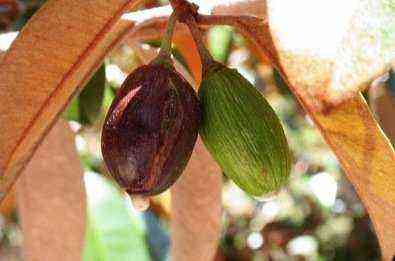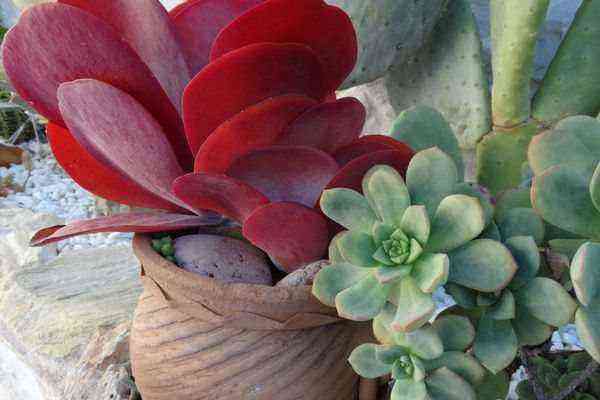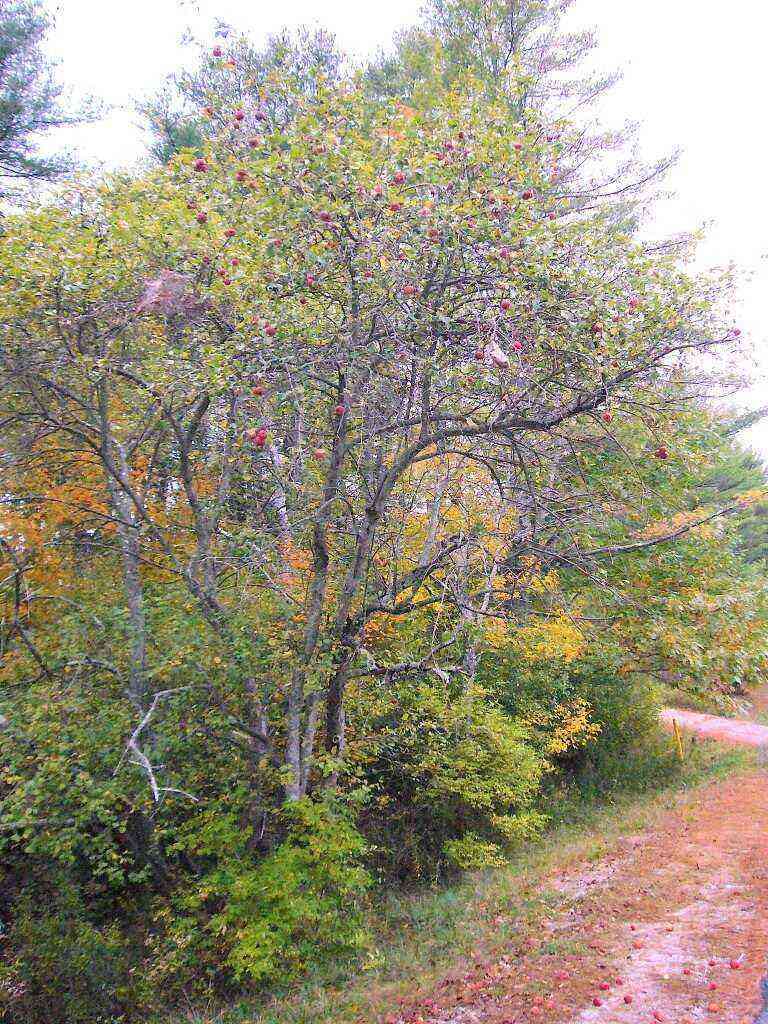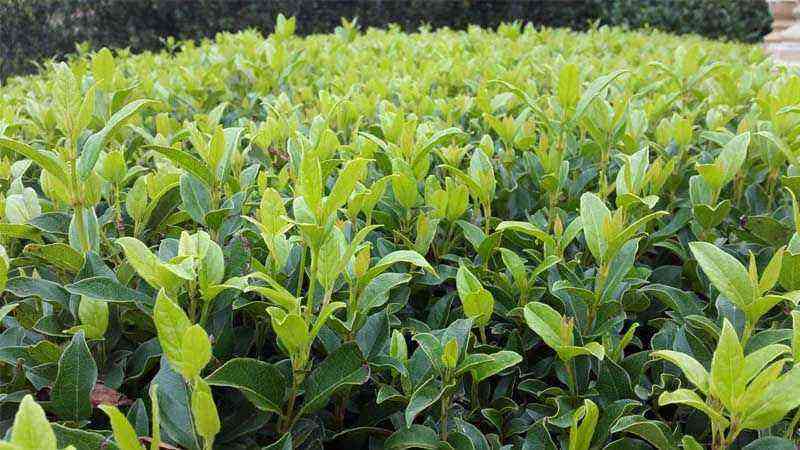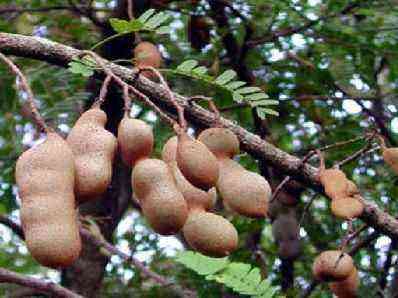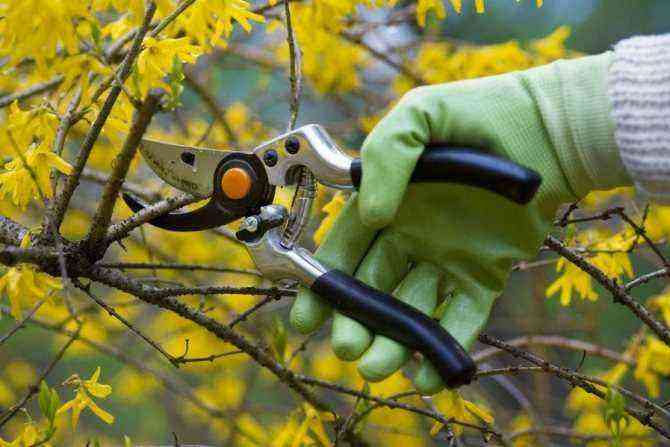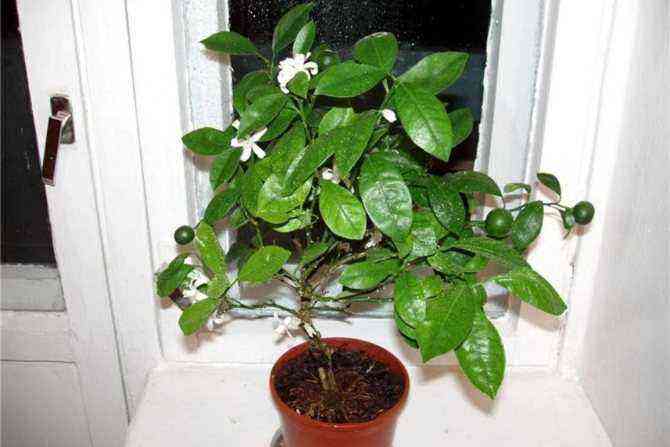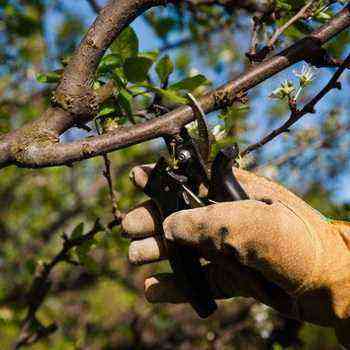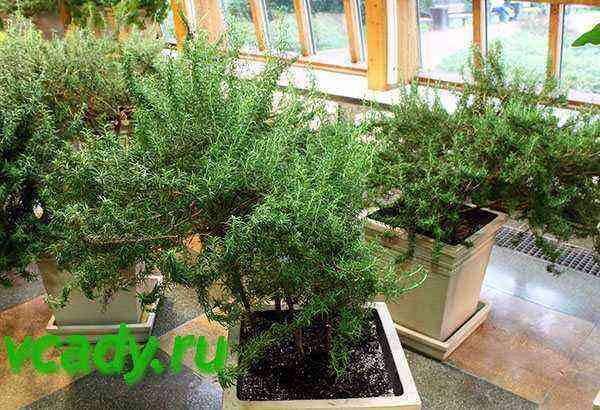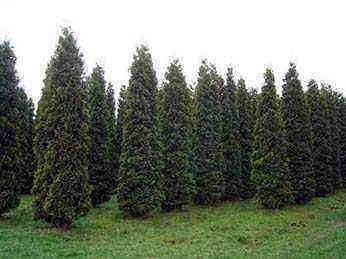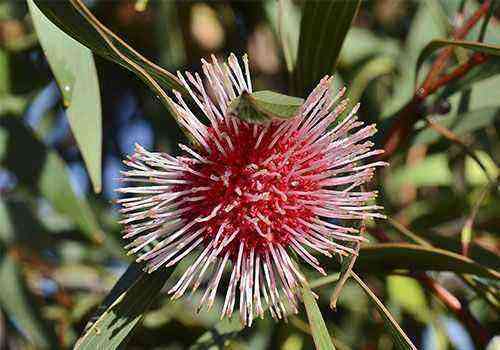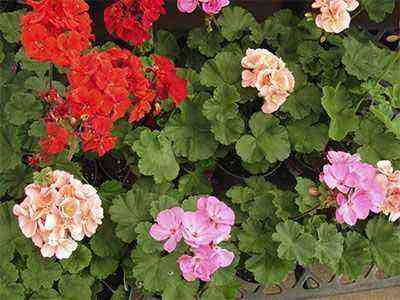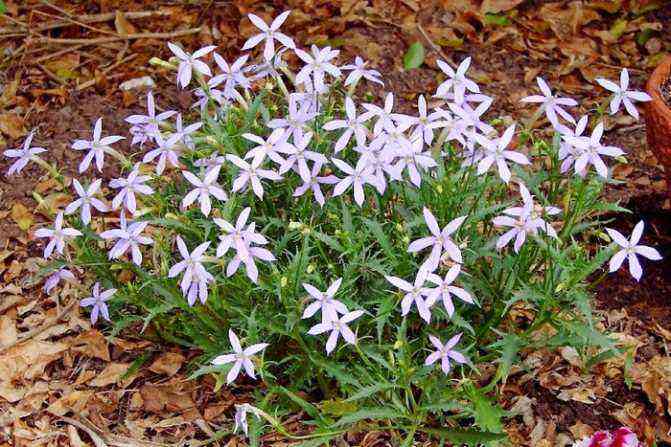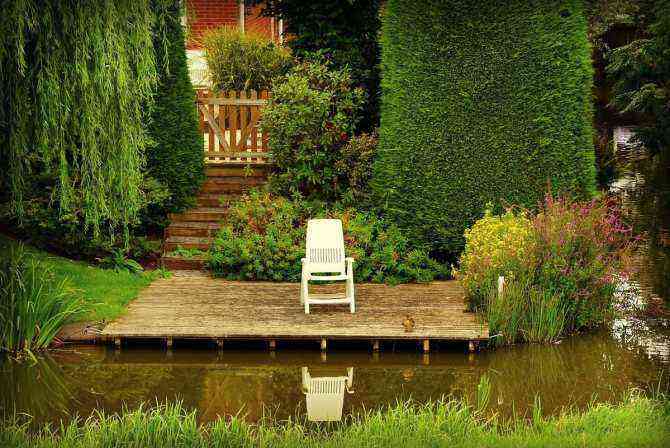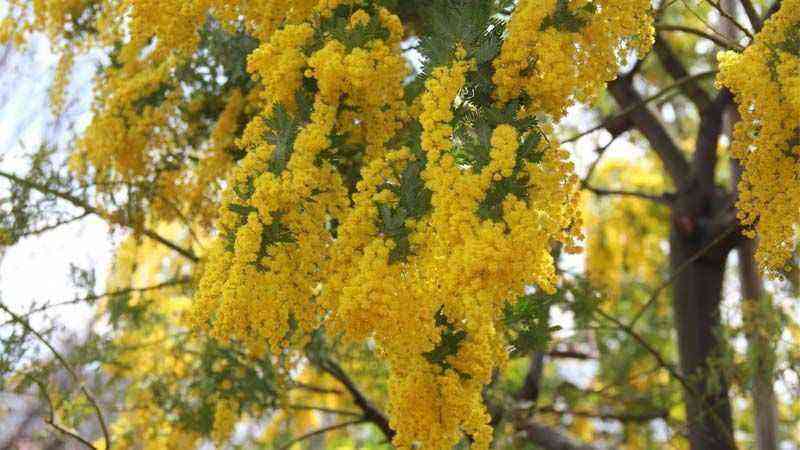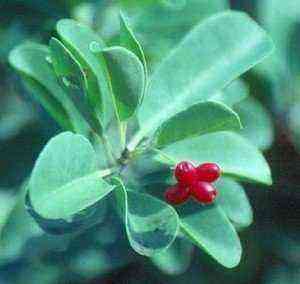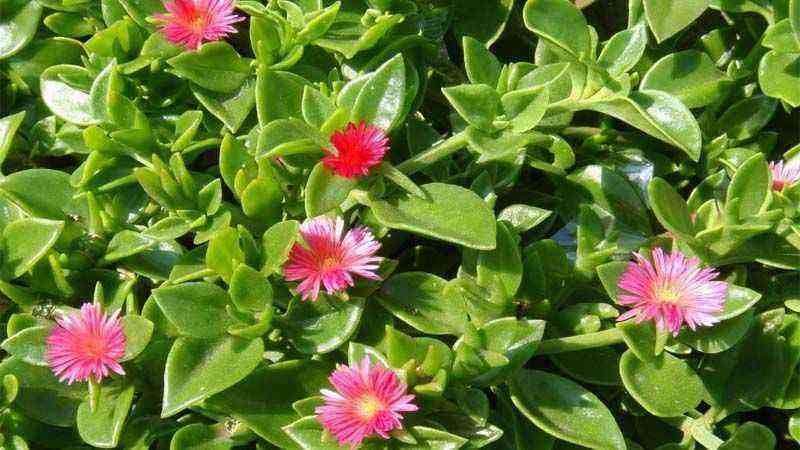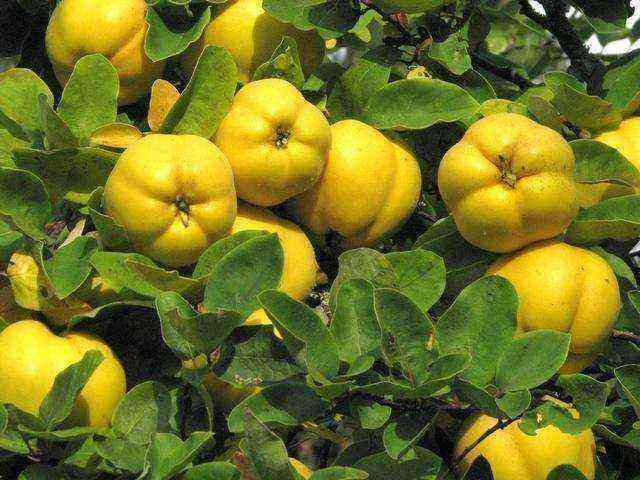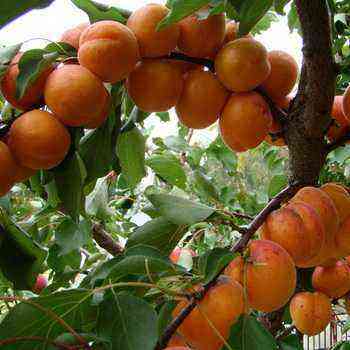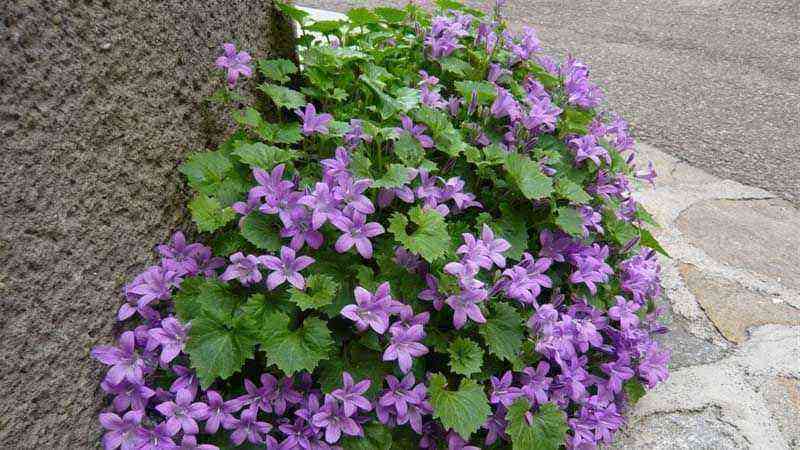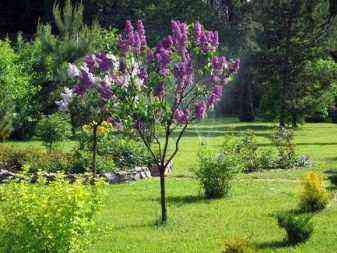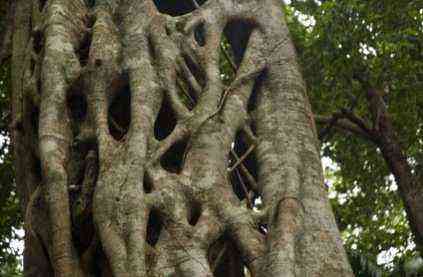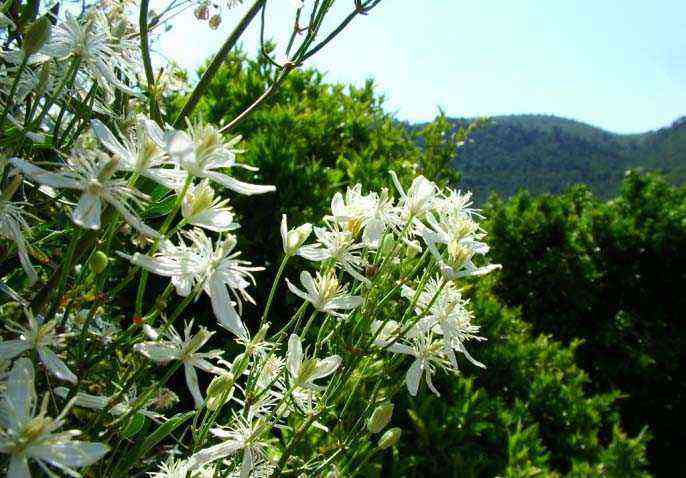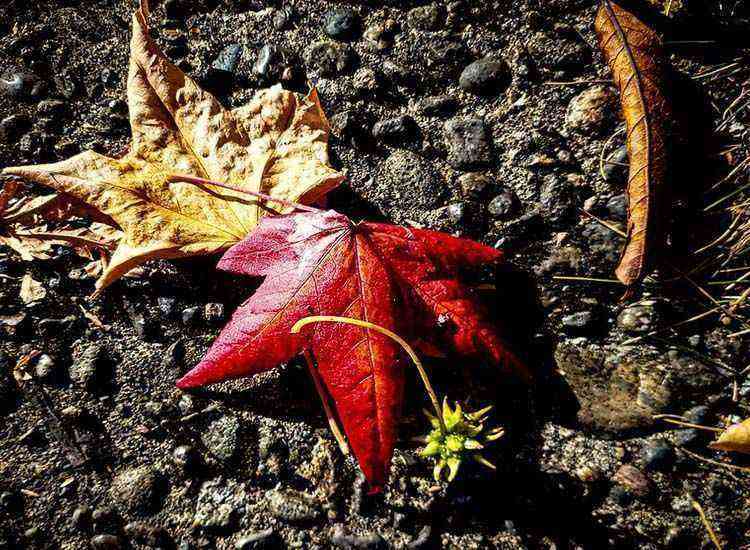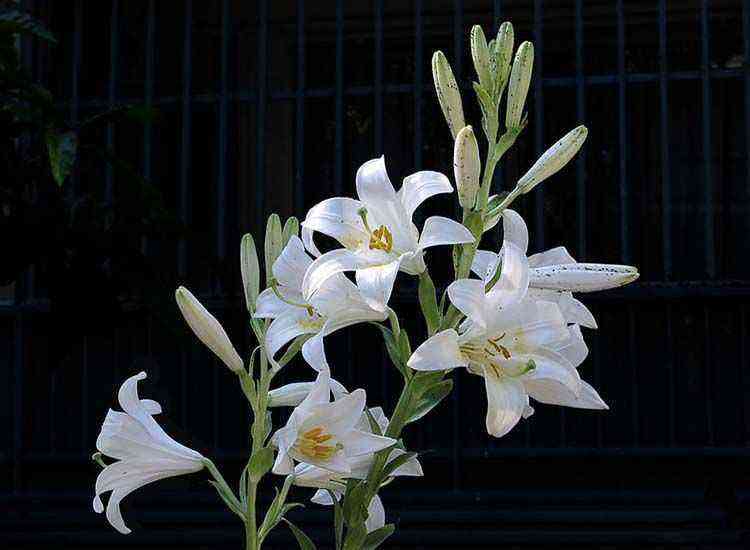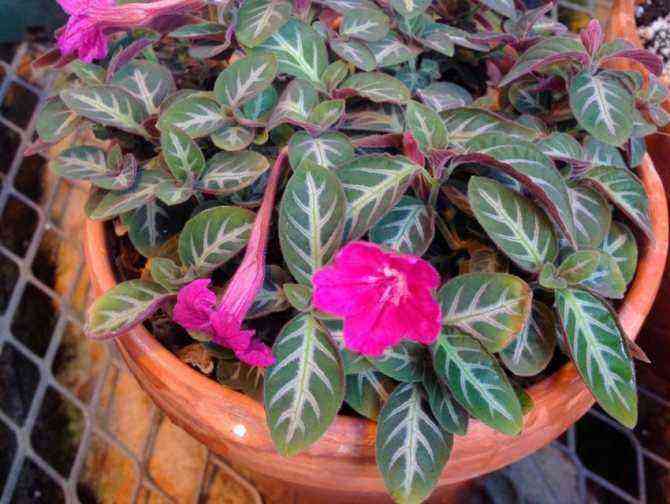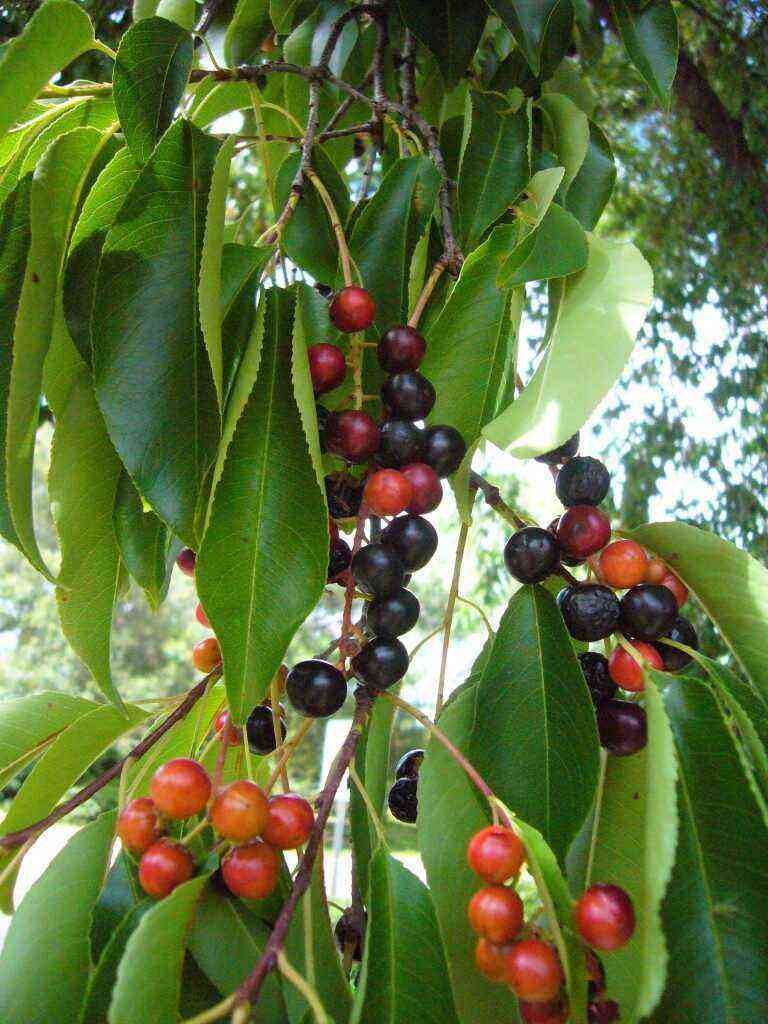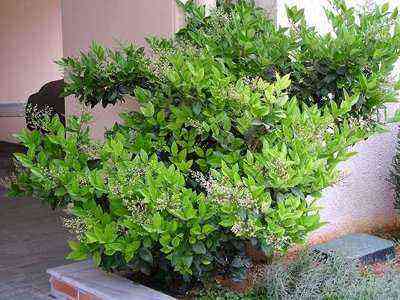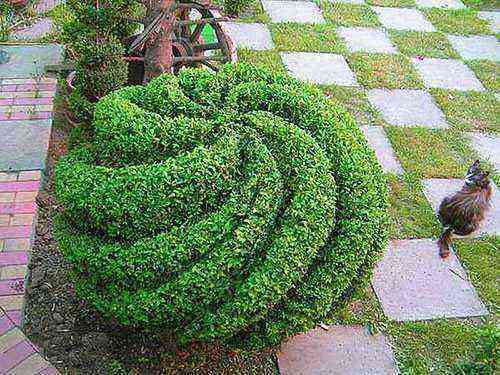

Forming a dense, easy-to-cut and shaping crown, boxwood is one of the favorite plants of landscape designers. On the basis of this evergreen shrub with a dense compact crown and small leaves, not only green borders and living walls are created, but also amazing sculptural compositions.
On the subject:
Derain white – planting and caring for decorative …
April 28, 2020
Hydrangea tree-like – varieties with photos, a selection for …
April 27, 2020
Ezhemalina – landing and leaving in the suburbs for …
April 23, 2020
Garden camellia – planting and caring for a capricious Japanese woman
April 17, 2020
BACK FORWARD 1 of 49
Interest in culture today is greater than ever. What are the plant’s requirements for keeping conditions, and how to care for the boxwood so that the plant will delight for a long time with the shine of the foliage and the perfection of its shape?
In nature, there are more than four dozen species of boxwood growing in the Mediterranean countries, in Southeast Asia and India, as well as in Africa and Madagascar.


On the territory of Russia, there are two wild-growing types of boxwood: Colchis and Hyrcanian.
The most famous cultivated plant from this vast family is the evergreen boxwood, followed by the small-leaved and Balearic boxwood. These species are used in landscaping cities and parks, and are also grown as indoor crops. Garland’s whimsical boxwood is used to create miniature bonsai.
2.Samshit – home care
2.1 Propagation by cuttings and cultivation from seeds
Vegetatively using half-ripe stem cuttings. Seeds sown in spring. Germination occurs within 1 to 3 months if the seedlings are kept warm.

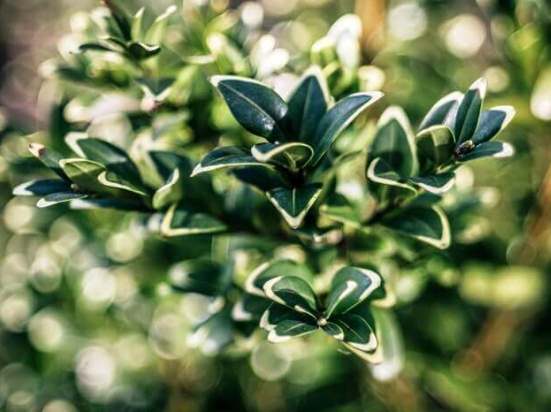
2.2 Soil for boxwood
For growing indoor boxwood, nutritious soil, loose with good drainage, is suitable, while the pH of the soil should be in the range from 6,5 to 7,2. A little lime is added to too acidic soil.
2.3 Diseases and pests
When kept cool, the leaves take on a bronze tint. Leaf spot. Root rot due to waterlogging or insufficient drainage.
Of harmful insects, plants can be attacked by nematodes, spider mites, and gall midges. leaf beetles, mealybugs, scale insects, moth, false scale insects.


2.4 How to transplant boxwood
The transplant is carried out with the beginning of new growth, in the spring. Young plants are transplanted annually, adult plants are transplanted if necessary to change the soil. In large tubular box trees, the top layer of soil is changed to a fresh one annually.


2.5 Growing, pruning
Pruning is carried out at any time of the year. Try to have several smaller haircuts than one cardinal one. With the help of competent pruning, the boxwood crown can be given any desired shape. When pruning, remove damaged or old branches. Pinch the tips of young shoots to form a lush crown.
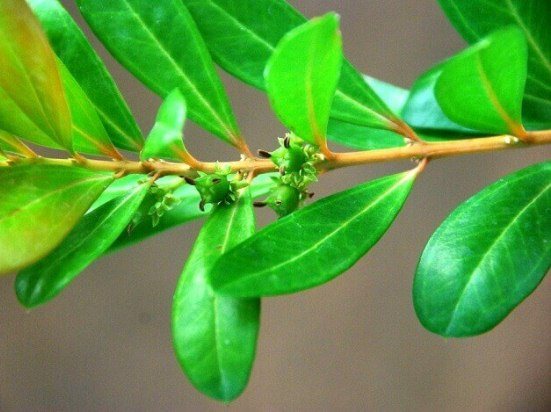
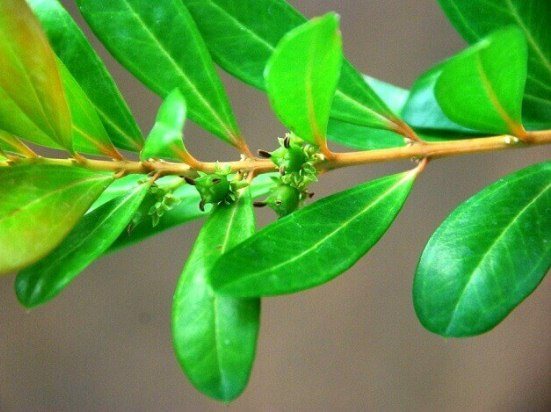
2.6 Fertilizer
During the growing season, boxwood is fed 2 times a month with liquid fertilizers, while at the end of summer it is worth using fertilizers with a low nitrogen content.
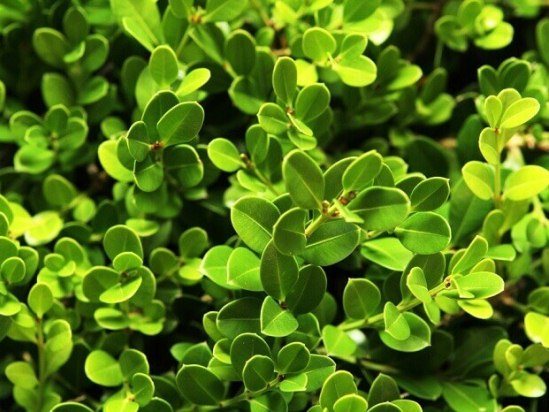

2.7.Life
During the period of active growth, boxwood in room conditions is watered abundantly, the upper part of the soil should dry out a little before the next watering. In winter, the frequency of watering is reduced. Any excess water accumulated in the pan must be removed.
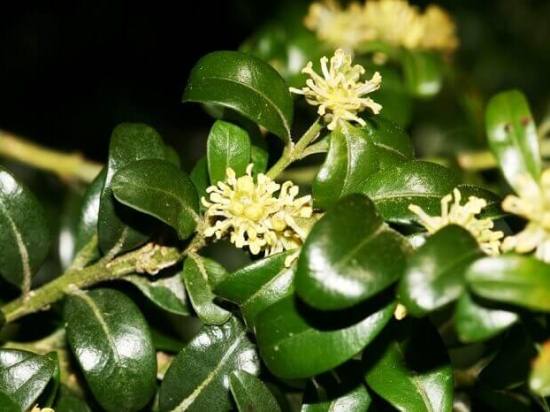
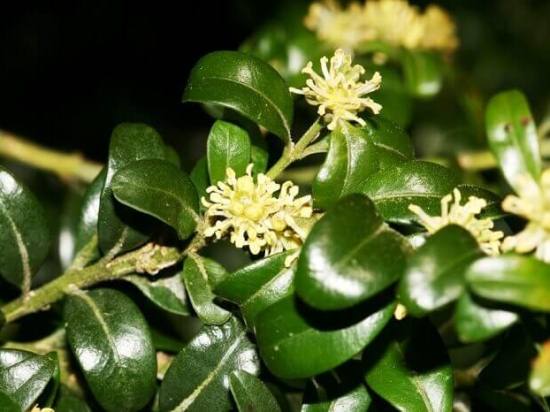
2.8 when it blooms
Flowering time — April May.
2.9 Containment Temperature
During the period of active growth, boxwood is kept at a normal room temperature of about 20 degrees Celsius, but in winter it should be placed in a cool room with a temperature of 3 – 8 ° C.
2.10 Application
Boxwood is unassuming and can be used for bonsai cultivation.
2.11 Lighting
Shade from hot direct sunlight during the daytime in spring and summer, the rest of the time boxwood can be sunbathing.


2.12 Air humidity
It is not necessary to spray the leaves of this houseplant – it is good for the dryness of living quarters, but it is worth remembering that keeping in an atmosphere that is too dry can lead to an invasion of pests such as red spider mites.


2.13 Note
In sensitive people, boxwood juice can cause contact dermatitis. The plant releases special substances into the air – phytoncides, which help fight bacteria and viruses.
Hydroponics .
Diseases and pests
On indoor boxwood, such pests can parasitize:
- shield;
- aphid;
- spider mite;
- boxwood gallium.


To exterminate pests insecticides are used.
It should be remembered that most pests affect weakened plants, therefore, adherence to the general norms for growing boxwood is some kind of prevention against infection.
One of the common ailments affecting boxwood is psill’s disease. Its signs are significant growth retardation, leaf deformation and the appearance of sticky waxy formations.
The affected plant parts should be removed and destroyed. With too much watering or insufficient drainage, brown spots appear on the leaves.
3. Varieties:
3.1. Evergreen boxwood – Buxus sempervirens
Evergreen trees or shrubs up to 9 m high with a rounded crown formed by abundantly branching, thin shoots of the plant. Small elliptical or lanceolate green, thick leaves up to 2,5 cm long are arranged in opposite pairs on short petioles. The lower surface of glossy sheet plates is often painted in a lighter shade. Small, yellowish, attractive flowers are collected in few-flowered axillary inflorescences, appear in spring. During the flowering period, the plant emits a very pleasant aroma.

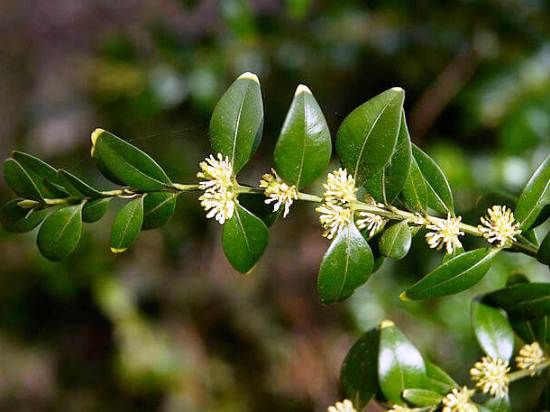
3.2. Colchicum boxwood – Buxus colchica
Large evergreen shrub or small tree with abundantly branched shoots. Leaves are thick, entire, arranged in opposite pairs, have a glossy surface and a pronounced central vein. The flowers are small, greenish-yellow, without petals, but with long, fluffy stamens, appear along the entire length of the stems in the leaf axils.
There are variegated plants with thin, light stripes along the edge of the leaf blades.

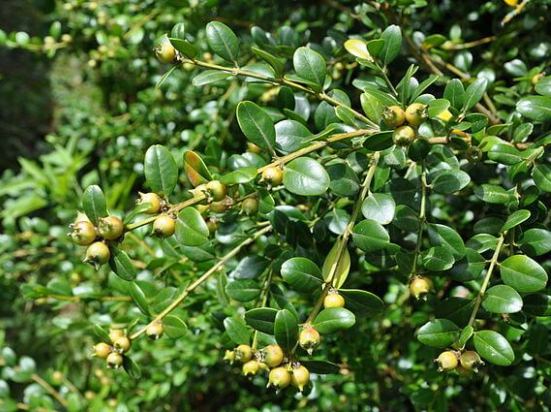
3.3 Small-leaved bauxite – Buxus microphylla
Evergreen shrub with erect, dense shoots and small, opposite, simple leaves. The leaf blades are whole-edged, oval, 1 – 3 cm long, colored in different tones of green. The flowers are small, collected in small axillary inflorescences.
This attractive plant is widely used outdoors to create hedges.

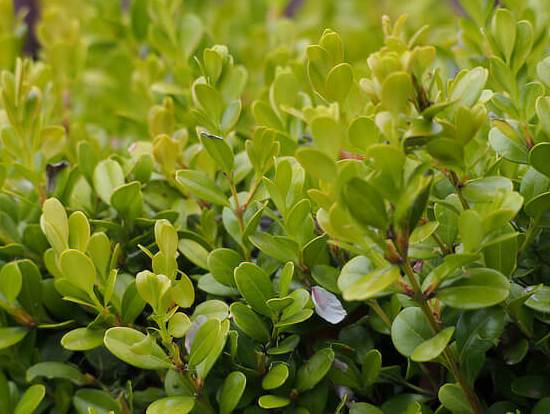
3.4.Samshit Chinese – Buxus sinica
Dense, compact, multi-stemmed, evergreen shrub up to 1,5 m high. This variety is distinguished by good frost resistance. The leaves are oval, thick, small – up to 2 cm long, on short petioles, glossy, colored in all shades of green. The flowers are axillary, greenish-yellow, fragrant, appear in spring. Flowers are rare and insignificant, but quite fragrant.

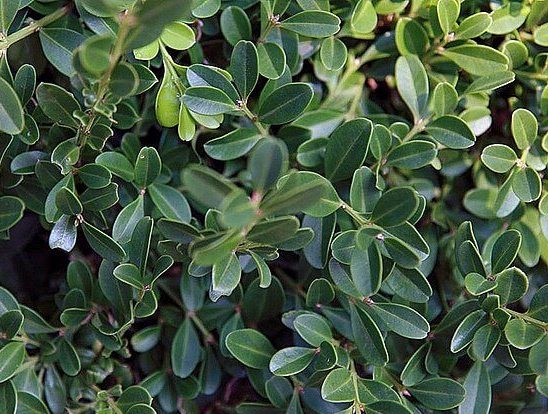
You may also be interested in:
House boxwood in a pot is ideal for fans of evergreens. A beautiful ornamental shrub is suitable not only for open ground, but also for tub cultivation, and in many ways, caring for a home boxwood becomes easier.

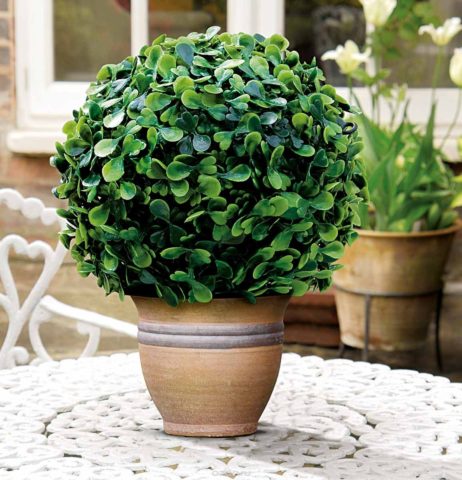
Pruning, shaping and flowering boxwood
The first cutting of evergreen bushes is desirable in late April – early May. Considering that boxwood grows rather slowly, it is recommended to cut it to a minimum: slightly correct the crown and cut only new growths. In the future, it is necessary to carry out a haircut once a month until the end of summer; it is advisable to compensate for more frequent pruning with additional watering.
To form a standard tree, it is necessary to choose a plant with a sufficiently strong central trunk, shorten all lateral shoots to the desired height, and cut the remaining ones slightly. This will enable the plant to branch better and over the years, you will become the owner of a tree with a gorgeous crown in the form of a ball on a slender leg.
In our area, boxwood blooms very rarely in March-April with small greenish or yellowish flowers, which, however, do not add any special beauty to the plant, but have a pleasant honey aroma. Everyone is well aware of the true value of boxwood – a beautiful evergreen crown with a green or variegated color of leaves, which determines the main types of boxwood – green and variegated.
Is it possible to keep boxwood in an apartment
Boxwood is an unpretentious evergreen shrub that adapts well to being kept indoors in a pot. As a rule, the height of such a houseplant does not exceed 60-100 cm; it is rarely necessary to transplant a shrub, since it grows very slowly. The photo of a home box tree shows that the shrub looks very attractive in the interior – the dark green crown lends itself well to forming, and a plant in a pot can decorate any room.
The potted boxwood has some peculiarities, for example, it does not bloom under indoor growing conditions. However, even in the absence of flowering, boxwood at home in a pot will grow very beautiful. In addition, it purifies the air and eliminates harmful bacteria present in it, thereby improving the home atmosphere.
What types of boxwood are suitable for home
For potted cultivation, it is recommended to buy shrub varieties designed specifically for indoor cultivation. As a rule, they are characterized by low maximum growth, high crown density and resistance to strong pruning. There are several species that grow well in small indoor tubs.
Small-leaved boxwood (Buxusmicrophylla)
Shrub with a small, but very dense crown, consisting of leaves of 2-2,5 cm each. The plant grows slowly, keeps its decorative shape well and rarely requires a formative haircut.
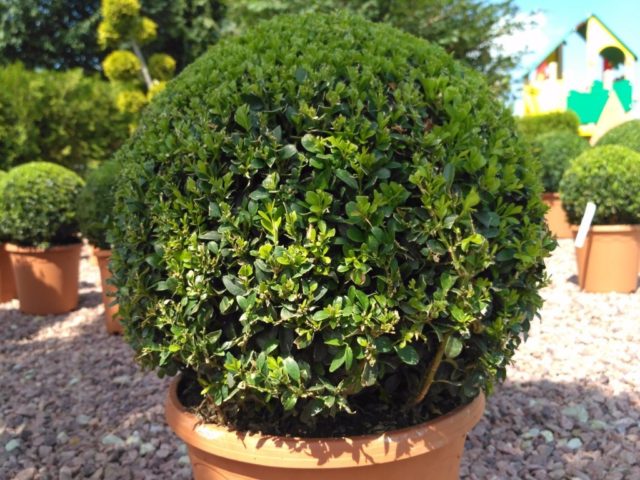

Balearic boxwood (Buxusbalearica)
Shrub with large and patterned leaves of bright green color. It is known for its very ceremonial decorative appearance, it grows quite quickly, but this allows lovers of evergreen plants to experiment more often with the silhouette of a shrub.


Caucasian boxwood (Buxuscolchica)
Slow-growing shrub with a life expectancy of up to 500 years or more. The leaves of the shrub are rounded-oblong, ovate, curling at the edges. Caucasian boxwood is very thermophilic, and therefore is much better suited for growing in a pot than for planting in an open field.


Boxwood Compact (Buxusmicrophylla Compacta)
A dwarf plant about 30 cm tall, with very small leaves up to 1 cm each and a dense crown. The mini-shrub grows very slowly, and takes up little space, so it is well suited for home interiors.
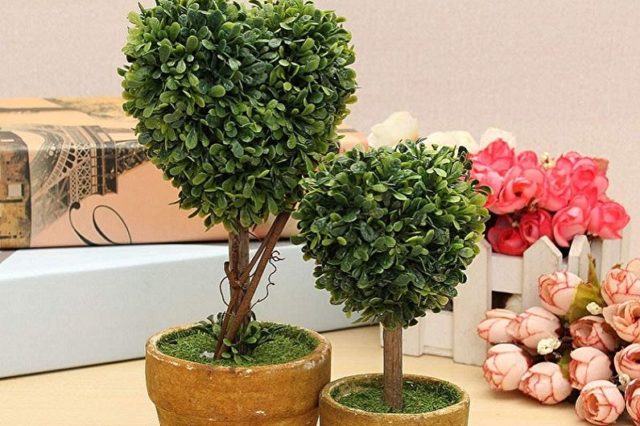

As for the ordinary evergreen boxwood, or Buxussempervirens, it can also be planted in pots – the species adapts well to indoor cultivation. But caring for an ordinary boxwood will be more difficult than for dwarf and hybrid species, the plant is sensitive to growing conditions and, at the slightest mistake, sheds its leaves and loses its decorative effect.
Planting boxwood in the garden
Having decided to plant boxwood, you should first of all decide on the variety and purchase planting material from a trusted supplier. Among its many species there are plants – dwarfs and giants, with different temporal indicators of growth, color of leaves and shape. Slow-growing varieties are best for growing green borders, evergreen boxwoods or varieties of vigorous species are successfully used for hedges, and for figurines from plants it is worth choosing varieties depending on growth and frost resistance.
When buying seedlings, it is advisable to inspect the plants visually, paying attention to the color, which should be juicy – green and the appearance of shoots and leaves. If the plant has bare stems or yellow leaves, then it is best not to take it in order to avoid further problems. Experts advise buying seedlings about 10 centimeters higher than planned, so that in 3 to 4 weeks after planting, you could trim the tops and get a flat horizontal surface. This helps the seedling to adapt faster, since the crown is partially reduced and the roots better nourish the plant as a whole.
Before placing the seedling in the hole, it is necessary to untangle and straighten the roots, prune the dried ones and lower the plant to the depth of growth of the old coma or container, placing the trunk vertically, cover it with a mixture of earth with expanded clay or perlite in a 1: 1 ratio and compact the earth so that there are no voids. For single plantings, prepare planting holes of suitable size, approximately three times as deep and wide as a clod of earth removed from a pot.
To create a drainage layer, it is necessary to pour perlite or expanded clay on the bottom of the pit in a layer of up to three centimeters. When planting a hedge, it is necessary to place about 1 seedlings per 5 running meter, leaving 20-25 cm between them.To form parterre carpet compositions or low borders, it is necessary to plant the plants in a checkerboard pattern, at a distance of 15-20 centimeters between the bushes, while it is good tamping the soil between the plants. It is also advisable to make a recess along the entire hedge, which should be filled with water 3-4 times during the first 2 weeks after planting.
Boxwood prefers to grow on clay or calcareous soils, with a lime content, good drainage and water and air permeability. Dislikes wetlands or lowlands where water can stagnate. Boxwood gives a strong growth only on nutritious, well-fertilized soils, it is advisable to feed poor lands when planting, mixing with a nutritious substrate of dry humus, leafy soil, peat, humus. Newly planted plants need to be watered abundantly at the rate of 1 bucket of water per plant and then continue watering after 3-4 days. In case of drought, it is advisable to increase the number of watering and water them at the rate of 1,5 – 2 buckets per seedling. Then mulch with peat or rotted coniferous needles.
The optimal place for planting boxwood is light partial shade, since direct sunlight can contribute to the appearance of yellow or dried leaves. Young plants are especially bad at tolerating bright sun in clear frosty weather, so the combination of frost and sun is not comfortable for boxwood to live.
The best time to plant boxwood is spring, so that the seedlings can take root well and prepare for the winter frosts, however, you can plant plants in the fall, from about early September to mid-October, with a month left before the onset of cold weather. The productivity of spring planting directly depends on the application of nitrogen or complex fertilizers, which, in addition to potassium, phosphorus and sodium, also contain additional microelements. As an option for fertilizing evergreens, you can use Chimera and do not forget that boxwood needs additional feeding with magnesium.
The mild climate of Ukraine makes it possible to transplant box trees throughout the season – from March to October, and the plants themselves can be of any age. Planted hedges need abundant watering in the summer so that the plants can take root well and prepare for the frost. Plants from 3 to 8 years old can be transplanted with a clod of earth almost all year round, excluding the cold winter months. When buying seedlings at a later date, it is advisable to dig them in in a shaded place before the onset of spring. With proper care, mulching and regular watering, evergreens grow and develop well, and seedlings of the first year require increased attention and can successfully survive the winter, being under a layer of snow. Boxwood has good immunity to winter frosts, but does not tolerate drying winds and the scorching sun, which may be the main reason for its failure to grow.
Features of growing boxwood in a pot
A shrub in a pot can become a real decoration of a home interior, it looks good both in groups and alone, it becomes a bright accent in a room, refreshes and enlivens a room. But in order for a green shrub to be truly decorative and graceful, it is necessary to comply with all the requirements for growing in a pot and follow the rules for caring for indoor boxwood at home.
- An evergreen indoor shrub needs good, stable lighting. It is not recommended to expose it to direct sunlight, but boxwood and thick shadow will not suit in the same way. It is best to place it near the south, east or west windows in an area of diffused daylight. Natural light for a shrub in a pot is strictly required – the bush does not perceive artificial illumination, and it cannot replace sunlight.
- Boxwood needs fresh air, so you will have to ventilate the room as often as possible. This has a beneficial effect on the growth of the shrub, in conditions of good oxygen access, it becomes less capricious and sensitive. In the summer, boxwood in pots is often exhibited outside – in the courtyard of a private house, on a balcony, loggia or terrace, while providing it with a little shading.
- When caring for boxwood in a pot, it must be remembered that it needs high humidity, excessive dryness harms it. Providing the necessary conditions is quite simple – you need to regularly spray the shrub. It is required to pay attention to spraying not only in dry summers, but also in the autumn-winter period due to central heating, the air humidity in apartments often drops dramatically.
As for the temperature, the best boxwood in a pot feels at 23-25 ° C. The shrub does not tolerate heat well, so in the summer you need to ventilate the room in which the pot is located more often, and additionally humidify the air. In spring and autumn, a strong drop in temperature up to 12 ° C is permissible. As for the winter time, the ideal temperature regime will be + 5-10 ° С, and if it is impossible to create such conditions – 12-16 ° С.
Boxwood pests and diseases
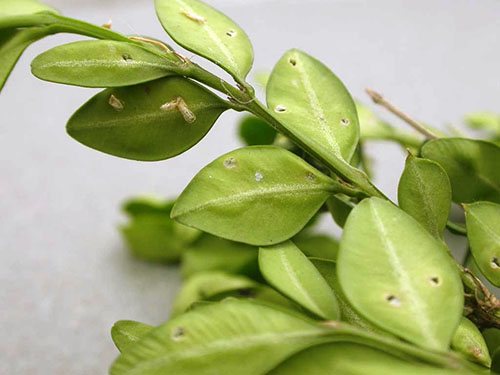
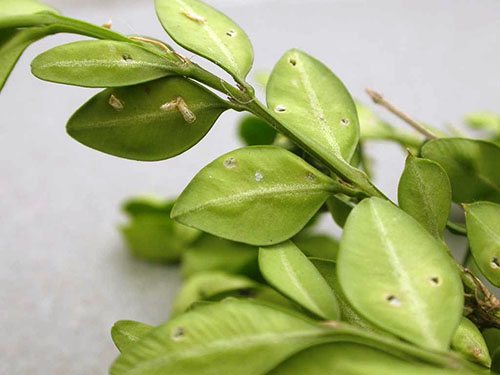
Most cases of loss of visual appeal by a shrub, as well as damage to a plant by pests and diseases, are associated with a violation of the rules for caring for boxwood at home:
- Excessive watering in the cold season leads to root rot and other boxwood diseases.
- Drying out of the soil and dry air in the room is the reason for the loss of foliage and drying out of the young parts of the shoots.
- If the air temperature remains above 18 ° C for a long time, then the boxwood also begins to lose leaves and weaken.
Neglect of fertilizing, frost damage and other factors also lead to the weakening of the plant. Boxwood diseases and pests affect precisely weak, emaciated specimens.
Among the pests that can quickly settle on a weakened plant are spider mites, boxwood gall midges and various types of scale insects. The leaves of the bush are affected by the larvae of miner flies, which lay their eggs in plant tissue.
Modern insecticides and fungicides are used to control larvae, ticks and caterpillars on box trees. Sick and pest-affected shoots are cut and destroyed. At the same time, they must establish caring for the boxwood at home, providing the plant with proper watering, temperature conditions and feeding.
Caring for boxwood in a pot
Caring for a boxwood in a pot is not very difficult, but requires attention. It is important to take care of the quality of the soil and the frequency of watering the plant, as well as timely decorative pruning.
What land is needed for planting boxwood in a pot
The shrub is undemanding to the ground for home cultivation in a pot; both universal soil and mixtures for ornamental deciduous crops are suitable for it. The main condition when choosing soil for boxwood at home is looseness and air permeability of the soil. When self-preparing the substrate, you can mix turf, sand and leafy soil in proportions of 4: 1: 2.
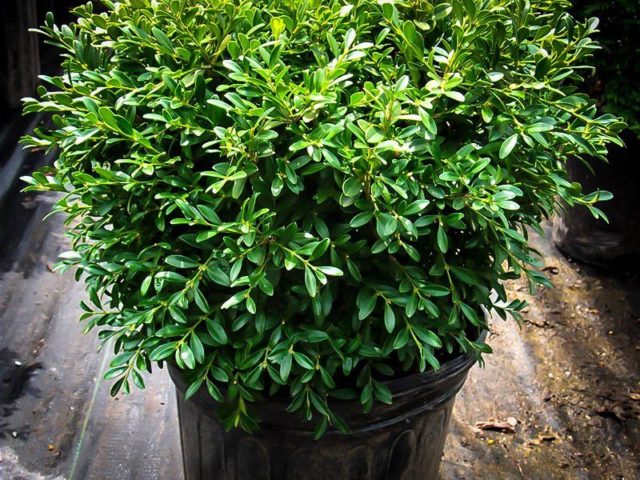
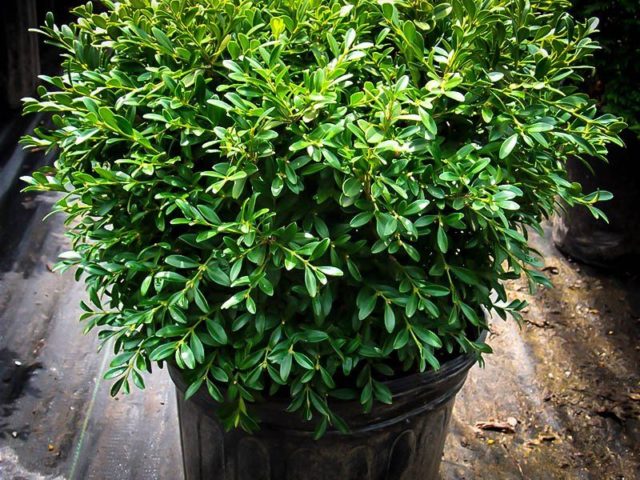
Boxwood grows very well in nutrient soil in a pot, but many indoor plant lovers deliberately deplete the soil for the shrub. The fact is that in poor soil, the plant produces shorter shoots, and its crown thickens, for decorativeness this is only beneficial.
Watering and feeding home boxwood
An evergreen shrub in a pot has a negative attitude towards both excessive moisture and lack of moisture. Therefore, when watering, it is important to maintain a balance – the substrate should always remain slightly moist, but not waterlogged. It is recommended to water the shrubs so that only the upper part of the soil has time to dry out during the breaks; in winter, the intervals between waterings are increased.
The water for the shrub in the pot must be defended before watering, and even better, keep the container in a lighted place so that the water is slightly lukewarm. It is possible to spray the shrub with cold water, but it is also recommended to stand the liquid for 1-2 days beforehand.
Both in the open field and in the pot, the plant needs regular feeding. Usually, for young plants, fertilizers are applied once every 2 weeks, and for adults – once a month, and the plant should be supplied with fertilizers only during the period from March to August.
A shrub in a pot takes up conventional universal mixtures well. But if you wish, you can feed it with special fertilizers for evergreen rhododendrons, the composition of such dressings is perfectly balanced.
Trimming and shaping
Pruning is one of the most important elements of caring for and growing boxwood in an apartment. It is regular trimming that allows you to give the bush the desired decorative shape and turn it into an element of home design.
- It is customary to trim the bushes from spring to early autumn. Young plants are best trimmed at the beginning of July, and if the boxwood is an adult and has already been pruned, then trimming can be done sooner or later.
- An evergreen shrub in a pot tolerates cutting of any intensity, even strong pruning does not harm the plant. It is necessary to carry out the formation in accordance with your wishes for the silhouette of the bush.
- To slow down the growth of a bush in a pot, its young shoots can be pinched at the tips – a useful effect will also be that after this procedure the crown of the plant will become thicker.
Plant transplantation
As a rule, boxwood in an apartment grows very slowly, but sometimes it still has to be transplanted into another container.
- It is recommended to transplant only when necessary, after the root system of the plant has completely entangled the substrate in the existing pot. On average, this takes about 3 years, respectively, and it is necessary to transplant the shrub with just such a frequency. The exception is dwarf bonsai boxwoods, it is better not to replant them at all, so as not to harm the plants.
- It is necessary to transplant from pot to pot in spring or summer – during the period when the plant is actively growing. You should not transplant the shrub in the fall and even more so in the winter, at this time the boxwood is in a “dormant” state and will not take root well in a new place.
- In order to avoid damage to the root system of the plant, it must be transplanted together with the old earthen clod. You can remove only the top layer of the old soil, but you do not need to touch the ground around the roots.
The new pot should be slightly larger than the previous one – a maximum of 2-3 cm in diameter. It must be remembered that the ornamental bush grows slowly, and too spacious a container and a large amount of undeveloped soil harm the plant.

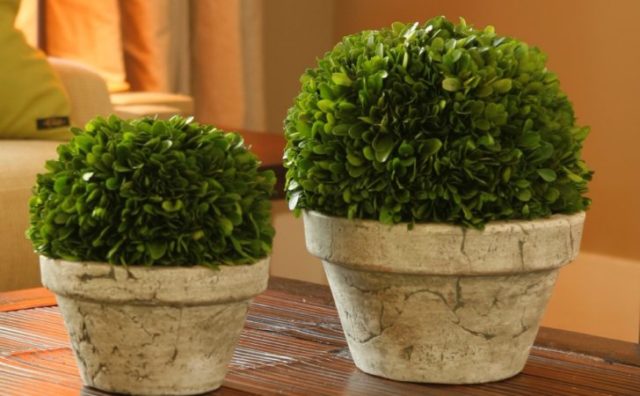
Protection against diseases and pests
The houseplant boxwood is much less susceptible to the influence of diseases and pests than shrubs living in the open field. This is natural, as the indoor microclimate by definition reduces the likelihood of infection by fungi or insects.
However, even in the home, the plant can suffer from ailments and pests.
- Boxwood diseases occur mainly due to improper care – waterlogging of the soil, especially in winter, drying out of the soil, insufficient spraying.
- Against the background of all of the above, root rot, wilting of leaves and weakening of shoots can develop.
- Due to serious mistakes in the care, the boxwood can even completely shed the foliage, and it is likely that it will not be possible to restore it.
To protect the shrub from ailments, recommendations for growing a plant in a pot must be fully followed. It is necessary to observe the frequency of watering, do not forget to humidify the air in the room, do not allow an excessive decrease or increase in temperature. Do not neglect the periodic feeding of boxwood in a pot, they strengthen its resistance to ailments.
Boxwood – planting, care, reproduction
November 30 2015
The most popular evergreens, confidently leading, both as a hedge in garden plots, and growing in small flowerpots are box trees.
Plants with their dense greenery outwardly resemble a real solid wall, and the crown, when properly pruned, can easily take on various forms.
Slowly growing representatives of the Boxwood family reach a height of 2 to 12 meters, belong to long-lived plants, some specimens of which can live up to 500 years.
Since ancient times, boxwood has adorned garden plots and has been successfully used in decorative landscaping due to its beautiful dense crown, even shiny leaves and good cold resistance, which is a characteristic feature of almost all evergreens.
The disadvantage of this beautiful plant is that all its parts, and especially the leaves, are poisonous enough, but this feature does not threaten the environment, since the poison is dangerous to the body only when ingested.
The only condition is that boxwood growing indoors must be placed out of the reach of children.
Boxwoods in apartments
Due to slow growth, evergreen indoor plants are very popular, which, adding no more than 5 centimeters per year, occupy very little apartment space.
Boxwood: small-leaved – with the smallest leaves from 0,5 to 2,5 centimeters; bolear – with larger leaves growing up to 4,5 cm and evergreen – with an average leaf size within 3 cm, are most in demand and perfectly adapted to living in a limited space of a flower pot or container.
Despite the unpretentiousness of the boxwood, with improper care, it can express “dissatisfaction” with the dumping of leaves, so you should observe all the conditions for its good growth.
First of all, place the plant in a place where the rays of the sun can fall, as an option on the windowsill of the apartment from the sunny side. Placing the flowerpot in a low-light location may make it less decorative.
Also, boxwood needs a moderate temperature, and in winter it needs to live in cooler conditions.
The roots of the plant do not like excessive moisture or dryness, therefore, experts recommend covering the surface of the earth with pebbles or moss and regularly sprinkling the leaves so that they do not dry out and curl, as this can contribute to the appearance of a scabbard or spider mite.
Prerequisites for good growth of home boxwood are transplanting it in 2-3 years into soil consisting of 2 parts of leafy soil, 4 parts of turf and 1 part of coarse sand, fertilizing with a complex of mineral fertilizers and regular removal of the container to fresh air in light partial shade.
You can easily form an unusual plant from an indoor boxwood by cutting the crown, like a cone, a ball, or something that comes from your imagination.
Planting boxwood in the garden
Having decided to plant boxwood, you should first of all decide on the variety and purchase planting material from a trusted supplier.
Among its many species there are plants – dwarfs and giants, with different temporal indicators of growth, color of leaves and shape.
Slow-growing varieties are best for growing green borders, evergreen boxwoods or varieties of vigorous species are successfully used for hedges, and for figurines from plants it is worth choosing varieties depending on growth and frost resistance.
When buying seedlings, it is advisable to inspect the plants visually, paying attention to the color, which should be juicy – green and the appearance of shoots and leaves. If the plant has bare stems or yellow leaves, then it is best not to take it in order to avoid further problems.
Experts advise buying seedlings about 10 centimeters higher than planned, so that in 3 to 4 weeks after planting, you can trim the tops and get a flat horizontal surface.
This helps the seedling to adapt faster, since the crown is partially reduced and the roots better nourish the plant as a whole.
Before placing the seedling in the hole, it is necessary to untangle and straighten the roots, prune the dried ones and lower the plant to the depth of growth of the old coma or container, placing the trunk vertically, cover it with a mixture of earth with expanded clay or perlite in a 1: 1 ratio and compact the earth so that there are no voids. For single plantings, prepare planting holes of suitable size, approximately three times as deep and wide as a clod of earth removed from a pot.
To create a drainage layer, it is necessary to pour perlite or expanded clay on the bottom of the pit in a layer of up to three centimeters. When planting a hedge, it is necessary to place about 1 seedlings per 5 running meter, leaving 20-25 cm between them.
For the formation of parterre carpet compositions or low borders, it is necessary to plant the plants in a checkerboard pattern, at a distance of 15 – 20 centimeters between the bushes, while compacting the soil well between the plants.
It is also advisable to make a recess along the entire hedge, which should be filled with water 3-4 times during the first 2 weeks after planting.
Boxwood prefers to grow on clay or calcareous soils, with a lime content, good drainage and water and air permeability. Dislikes wetlands or lowlands where water can stagnate.
Boxwood gives a strong growth only on nutritious, well-fertilized soils, it is advisable to feed poor lands when planting, mixing with a nutritious substrate of dry humus, leafy soil, peat, humus. Newly planted plants need to be watered abundantly at the rate of 1 bucket of water per plant and then continue watering after 3-4 days.
In case of drought, it is advisable to increase the number of watering and water them at the rate of 1,5 – 2 buckets per seedling. Then mulch with peat or rotted coniferous needles.
The optimal place for planting boxwood is light partial shade, since direct sunlight can contribute to the appearance of yellow or dried leaves. Young plants are especially bad at tolerating bright sun in clear frosty weather, so the combination of frost and sun is not comfortable for boxwood to live.
The best time to plant boxwood is spring, so that the seedlings can root well and prepare for the winter frosts, however, you can plant the plants in the fall, from about early September to mid-October, with a month left before the onset of cold weather.
The productivity of spring planting directly depends on the application of nitrogen or complex fertilizers, which, in addition to potassium, phosphorus and sodium, also contain additional trace elements.
As an option for fertilizing evergreens, you can use Chimera and do not forget that boxwood needs additional feeding with magnesium.
The mild climate of Ukraine makes it possible to transplant box trees throughout the season – from March to October, and the plants themselves can be of any age. Planted hedges need abundant watering in the summer so that the plants can take root well and prepare for the frost.
Plants from 3 to 8 years old can be transplanted with a clod of earth almost all year round, excluding the cold winter months. When buying seedlings at a later date, it is advisable to dig them in in a shaded place before the onset of spring.
With proper care, mulching and regular watering, evergreens grow and develop well, and seedlings of the first year require increased attention and can successfully survive the winter, being under a layer of snow.
Boxwood has good immunity to winter frosts, but does not tolerate drying winds and the scorching sun, which may be the main reason for its failure to grow.
Care for boxwood
In caring for evergreen box trees, experts advise paying attention to plant signals such as yellowed or sun-dried foliage.
Basically, this can manifest itself towards the end of winter, when the root system is in a semi-dormant state, and the crown, under the influence of the sun, has already “woken up” and the lack of moisture leads to the fact that shoots with leaves dry, crumble or receive burns.
To prevent this from happening, it is advisable to cover the crowns with burlap or plain paper, and also monitor the place where the boxwood grows – in partial shade and covered with snow.
Also, before the onset of frost, at about the beginning of November, experts advise to water and mulch the near-trunk circle abundantly with peat, peat compost or rotted coniferous needles, the mulch should be about 8 -12 centimeters thick. It is not advisable to use dry leaves for shelter, since in warm winters the plant may develop fungal diseases or foliage discharge.
Stamp trees must be tied to supports so that they cannot break under the influence of wind or snow and tie the trunk with spruce branches or non-woven protective material. Lignified boles can simply be whitewashed like fruit trees, which will give them the opportunity to do without additional shelter for the winter.
Watering and feeding boxwood
Boxwood refers to plants that are not particularly demanding for watering, but in dry weather it needs additional moisture, and also accepts spraying of the crown very favorably, especially in young plants.
Experts advise, when planting seedlings in soil that is not rich in nutrients, add humus and humus, and for plants in flowerpots, use special fertilizers for boxwood – a liquid that is simply diluted with water and poured into the soil no more than once every 10 days, starting from the second half of April and ending in early August.
When preparing boxwood for wintering, it is necessary to feed it in the fall with fertilizers containing potassium, which accelerates the lignification of the shoots and increases the plant’s resistance to frost.
Do not forget to fertilize the shrub in early spring before the leaves appear, fertilizing with nitrogen, as an option, you can dilute 10 kg of mullein, 1 grams of urea or 15 grams of ammonium nitrate in 25 liters of water and fertilizers with minerals obtained from 20 g of nitroammophoska diluted in 10 liters of water …
Pruning, shaping and flowering boxwood
The first cutting of evergreen bushes is desirable in late April – early May. Considering that boxwood grows rather slowly, it is recommended to cut it to a minimum: slightly correct the crown and cut only new growths. In the future, it is necessary to carry out a haircut once a month until the end of summer; it is advisable to compensate for more frequent pruning with additional watering.
To form a standard tree, it is necessary to choose a plant with a sufficiently strong central trunk, shorten all lateral shoots to the desired height, and cut the remaining ones slightly. This will enable the plant to branch better and over the years, you will become the owner of a tree with a gorgeous crown in the form of a ball on a slender leg.
In our area, boxwood blooms very rarely in March-April with small greenish or yellowish flowers, which, however, do not add any special beauty to the plant, but have a pleasant honey aroma. Everyone is well aware of the true value of boxwood – a beautiful evergreen crown with a green or variegated color of leaves, which determines the main types of boxwood – green and variegated.
Reproduction of boxwood
Boxwood can be bred quite successfully, both by seeds and cuttings. Regardless of what kind of cuttings propagation is carried out: summer or winter (lignified), the survival rate is quite high and can reach from 80 to 100.
The beginning of summer cuttings depends on the lignified base of young shoots, which usually occurs from the second half of June to the second half of July. Before the onset of the growing season during spring pruning, it is necessary to prepare lignified cuttings, and autumn cuttings should be cut in late summer – early autumn.
Chopped cuttings should be at least 5-10 cm in length and have at least 2-3 internodes.
The prepared cutting should have no more than 2 upper leaves, and the lower leaves should be removed completely, after which it should be placed in soil obtained by mixing the same parts of the earth with peat and covered with plastic wrap or a glass jar.
It is advisable to water the planted cuttings every other day and do not forget to spray. After a month, the cuttings take root, and with the onset of autumn they should be assigned to a permanent place of residence, warmed for successful wintering.
Seed cultivation takes a lot of time and requires a lot of patience due to the fact that the evergreen itself is a slow-growing plant, so many gardeners prefer grafting or buying ready-made planting material.
Boxwood is a wonderful decoration not only for a garden plot, but also for a city apartment. It looks great in the form of a green border, a hedge, a picturesque arch or a gazebo, and topiary figures can turn the site into something extraordinary.
For its magnificent thick “hair”, which by means of shearing allows you to give the bushes various shapes, and then keep it for a long time, boxwood is among the favorites of designers engaged in the design of green beauty in our homes, conservatories or country courtyards.
Due to its non-capriciousness and unpretentiousness, evergreen boxwood growing on a personal plot is an excellent choice, because a bright and very attractive plant, with a lively shine of green leaves, can paint the most gloomy day, fitting into the interior around you.
Helpful article? Share with your friends:
← Vineyard care in …Vermiculite
→
Source: //dim-sad-gorod.com/publications/samshit-posadka-uhod-razmnozhenie/
Wintering boxwood in a pot
Evergreen boxwood belongs to heat-loving plants, therefore it tolerates wintering in indoor conditions much better and easier than in open ground. However, there are also some nuances here – the temperature of the boxwood in winter still needs a lower one. Rooms with a temperature of no higher than 5-10 ° C are considered ideal for wintering; if necessary, a shrub in a pot can be left for the winter at a temperature of 12-16 ° C, but not higher.
It is best to remove the plant pot on a glassed-in balcony or loggia for the winter period. Thus, the plant will receive the required low temperatures, but remain protected from wind and snow. Watering boxwood in winter should be reduced by about 2 times, the plant needs less water, and the soil dries more slowly at low temperatures. At the same time, natural lighting should remain sufficiently abundant; if possible, it is recommended to expose boxwood on a balcony with windows to the south, west or east side of the world.
Reproduction of boxwood in room conditions
Even in a single copy, boxwood for the home looks very attractive. But even more spectacular look a few shrubs, placed around the apartment. It is not necessary to buy expensive seedlings to increase the boxwood population, the plant can be propagated independently from an existing bush.

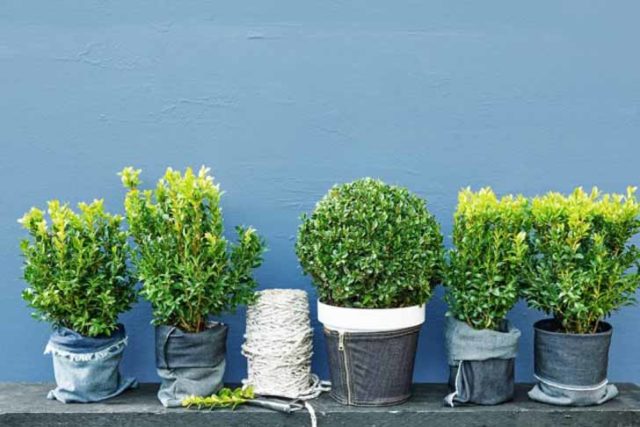
It is best to use the cuttings method. This requires:
- in spring or early summer, cut several cuttings up to 7 cm in length from an adult plant; it is better to choose shoots that have already begun to wood at the base;
- remove the lower leaves from the cuttings;
- for a day, hold the shoots in water with a growth stimulant, and then burrow into a substrate from the ground mixed with sand, and cover with cellophane film.
With a high level of humidity and regular ventilation, the cuttings will give roots in just a month. After that, they can be transplanted into larger containers and gradually grow to young shrubs.
If necessary, a seed propagation method can be used for indoor boxwood, but in practice it is used very rarely. It is much more difficult to care for a boxwood from seeds, moreover, seedlings grow slowly and do not enter a state of full decorativeness soon.
Reproduction of Boxwood Bonsai
Seeds
Reproduction can be done by sowing seeds. Only fresh seeds are suitable for germinating seeds.
Soak them in Growth Promoter and place them between the layers of raw tissue in several layers. There should be no excess moisture.
Whitish shoots will appear after 20-25 days. After that, sow the seeds in a special container with prepared soil (sand with peat) and cover with foil. Place the container in a warm, shaded place.
After sprouting, place the plants in a semi-shaded place and water them with water and fertilizers from time to time. And after the sprouts get stronger, transplant them to the right place and continue caring for the young plant.
When growing Boxwood Bonsai with seeds, the disadvantage is that the tree grows very slowly, a few mm per year. With this growth, it will be suitable for transplant only after 3-4 years.
Cuttings
In the spring, prepare the cuttings for future planting. Young branches, 15 cm long, should be soft and not completely hardened.
Cut them off at an angle and soak in a product (root or similar) for better rooting. Cut off a third of the leaves before planting in the ground. Cover each branch with a jar and air and spray daily.
After 1,5-2 months, remove the jar, since the formation of the root system is complete.
If the planting of cuttings is planned for the fall, then it is better to carry it out in pots so that the seedlings can survive the winter and form a root system. And in the spring, plant it in open ground.
Cutting Boxwood is the most effective way to propagate it.
Layers
In addition to cuttings, Boxwood can be propagated by layering. Dig a young twig into the ground in the spring. Water and fertilize until a rhizome forms. Then prune from the mother bush and transplant to the desired location.
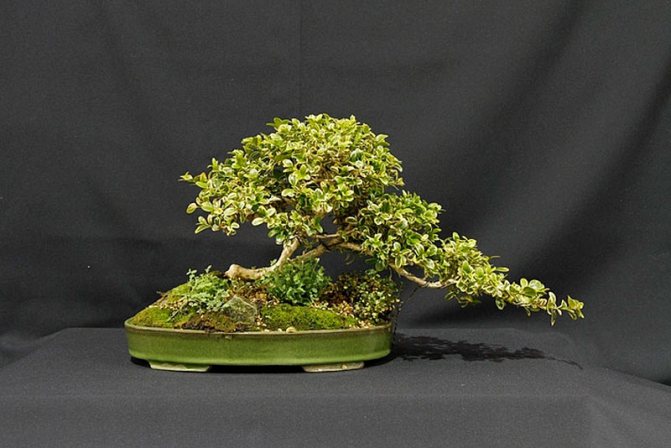

Boxwood in nature and in the room – differences and features
Boxwood is one of the most recognizable evergreen shrubs. This plant has long become a “must” not only in urban landscaping, but also in garden design. Boxwood is the main star of regular gardens and topiary. It is easy to recognize by both its growth pattern and the beauty of its strikingly dense foliage. But if in gardens or parks boxwood has long been perceived as a classic, then in the room it causes, at least, surprise.
Boxwood is such a “garden” plant that it is very difficult to imagine it in a closed space. But in recent years, along with the best conifers, boxwoods have begun to conquer new heights as indoor plants. In our country, they still seem like a curiosity and a novelty, but in the West they have long become one of the wonderful alternatives to the usual decorative leafy accents.
The first designers who flirted with the oriental style began to introduce boxwood into the interiors of the rooms. Today, boxwood is the main star of Chinese and Japanese restaurants, an amazing accent in modern interiors with a focus on minimalism.
In nature, boxwoods are found throughout the Northern Hemisphere, they are especially common in North Africa, the Mediterranean, and Western Asia. As an ornamental plant, boxwood is one of the most popular plants on our planet. These are representatives of the family of the same name Boxwood.
The exterior of indoor box trees is as recognizable as ordinary garden box trees. Despite the maximum declared height of 1 m, in rooms the shrub is usually limited to 30-60 cm. It is a densely branched, compact, slow-growing evergreen with an amazingly dense crown. Straight shoots are densely covered with sessile leaves in pairs. Small, up to 3 cm, glossy, with a central vein, elongated oval leaves of boxwood are easily recognizable not only by the characteristic shade of a dark green color, which changes on the back to a lighter one, but also by a pleasant smell.
Boxwood appears to be ideal in terms of density and crown texture. The plant naturally flaunts with dense contours, but indoor boxwoods, like garden ones, are grown only with the formation of strict silhouettes. Boxwood can be set to any direction of growth and any contour. Boxwoods do not bloom in rooms.
Beautiful green boxwood in the interior beckons to touch. But you need to be careful with the plant. All parts of box trees are poisonous, they contain dangerous alkaloids. The toxicity of the plant should be considered not only when pruning, but also when choosing a placement, because this plant is not suitable for growing in homes with small children or pets.
Home boxwoods fully reveal their phytoncidal talents. The plant is considered one of the most beneficial shrubs that can cleanse the air of bacteria and toxins.
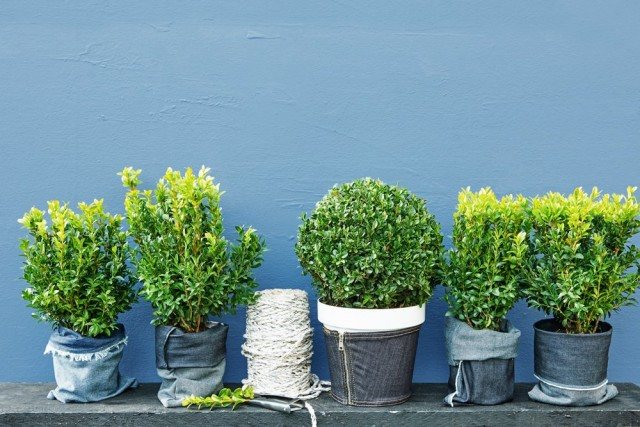

Boxwoods in pots. © hunted.design
Garden and indoor Boxwood: features, differences
Boxwood (Latin-Búxus) is an evergreen shrub belonging to the Boxwood family. This is one of the most popular plants that is used to decorate a garden area, park or square. Boxwood bushes lend themselves well to decorative curly haircuts.
We recommend related posts:
Spirea – description, types and varieties, planting and care
Common hazel – planting and care
The leaves of Boxwood are opposite, from elliptical to almost rounded, whole-edged, leathery. Flowers are very small, fragrant, unisexual.
But if the garden boxwood has already become a real classic, then the indoor boxwood is perceived so far as a curiosity, although outwardly the bush differs little from the usual garden one.
Home-grown boxwood is approximately 30-60 cm tall. This compact evergreen bush is densely covered with branches that create a dense crown. Stems are densely leafy. Leaves are sessile in pairs, oval, glossy, with a central vein. The length of the leaves is about 3 cm. From above, the leaf plates are colored dark green, from the inside they have a lighter shade. At home, Boxwood does not bloom.
Attention! All parts of Boxwood are poisonous, and therefore it is necessary to handle it with extreme care, observing safety measures. If there is a small child in the house, pets, then it is better to give up the desire to grow this plant in an apartment or house.
At the same time, the Boxwood bush is able to clean the air in the room from toxins, various bacteria.
Types of indoor boxwood
Boxwood species are rarely distinguished from each other. Most often, when buying a ready-made indoor plant, you can see the marking “common boxwood” or just the name of the plant. But it would be a big mistake to think that a single species of the entire genus of box trees is grown in the rooms – the dominant one in landscape design as well.
Boxwood or evergreen (Buxus sempervirens) is a visiting card of box trees, a species that can be transferred to a pot culture and grown indoors. But in room culture, two other types of boxwood, with more interesting foliage and a thickened crown, with compact sizes, show their properties better. Common boxwood is much more capricious, often sheds leaves, does not forgive mistakes in care.
Boxwood Small-leaved (Buxus microphylla) is a densely leafy, strikingly curly shrub. With leaves only up to 2,5 cm long, this boxwood is distinguished by slow growth, perfectly retains its shape and silhouette, practically requiring no frequent pruning. Due to its dense crown, it is considered the ideal boxwood for potting, it is the best choice if you want to create a strict “flawless” silhouette.
Bolear boxwood (Buxus balearica) is a very beautiful shrub with rather large, oval leaves, famous for its ornamental pattern, ceremonial appearance, bright, rich medium-green color. Leaves can exceed 4 cm in length. Due to its rapid growth, it is one of the best plants for experimenting with topiary art.
Boxwood ordinary or evergreen (Buxus sempervirens). © Mark Bolin Small-leaved boxwood (Buxus microphylla). © harum.koh Bolear boxwood (Buxus balearica). © Patrick Nicolas
Plant characteristics and features
Recently, more and more people began to grow it as a home, indoor plant. The reason is the beneficial properties that boxwood has. The plant releases phytoncides into the air. These volatile substances are able to neutralize harmful bacteria that accumulate in the air. It also has a pleasant smell, which is released during flowering or when pressed on the leaves.
It should be noted that only three types of plants are suitable for indoor cultivation:
You should pay attention to the fact that evergreen boxwood at home is quite whimsical. With the wrong care, he can easily shed the leaves.
Conditions for growing indoor boxwood
Despite its status as one of the most common plants, boxwood is far from easy to grow, even in horticultural culture. Failures often occur in the cultivation of this plant, since the boxwood’s dislike of winds, sensitivity to spring burns, dependence on the stability of winter temperatures and snow level are not always taken into account. In indoor culture, the selection of conditions for boxwood is as important as for its garden counterparts.
Indoor boxwoods in our range of flower shops are still a rarity. Both genuine indoor boxwood and potted boxwoods in malls can be purchased for indoor cultivation. This plant is affordable and widespread. If you wish, you can grow indoor boxwood from a rooted cutting, which is sold for the garden, or you can get a cutting yourself.
Caring for box trees at home
Indoor box trees are far from the most resistant and undemanding plants. Common boxwood can be considered one of the most capricious indoor shrubs, but the other two species do an excellent job with fluctuations in conditions.
Missing boxwood care will go away without consequences, only if we are talking about small deviations from the norm. In order for indoor boxwood to retain high decorativeness, you will have to take care of stable humidity, notice the slightest problems in its growth, and provide an influx of fresh air.
Watering and air humidity
Indoor boxwoods are watered carefully, maintaining a light, stable substrate moisture. The frequency of these procedures is set so that the topsoil dries out between waterings. Rare but not abundant watering is preferable. In winter, when kept cool, watering is made minimal, preventing the roots and leaves from drying out. Drought tolerates boxwood well, but only short. Prolonged drying of the substrate affects the decorativeness of the greenery.
An unpleasant surprise for many who want to have a boxwood in the room is his love for high humidity. Boxwood, especially in the heat, needs regular water treatments. For this shrub, there is no need to install industrial humidifiers or even pallets of moss. This garden plant is not only not afraid of getting wet, but also adores spraying.
Periodic or regular in the summer, conventional spraying significantly increases the decorative foliage and stimulates the growth of a luxurious dense crown.
For both watering and spraying box trees in a room culture, it is better to use settled water. The temperature of the water for spraying does not really matter, but it is advisable to use lukewarm water for irrigation.
Top dressing and composition of fertilizers
For indoor boxwoods, it is important to find a balance between maintaining stable soil nutrition and not having an excess of nutrients in top dressing. For this plant, it is enough to apply fertilizers with a frequency of 1 time per month for adult plants and 1 time per 2 weeks for young and actively growing box trees. With a standard frequency of fertilizing 1 time in 2 weeks, the dosage of fertilizers is halved. Top dressing for indoor boxwoods is carried out only from March to August.
For indoor boxwood, ordinary universal fertilizer is also quite suitable. But the best results are provided by the use of special fertilizers for rhododendrons. The balance of nutrients, macro- and microelements in such fertilizers provides foliage with a richer color and flawless appearance.
Pruning and shaping indoor boxwood
The optimal period for pruning any indoor boxwood is rightly called the beginning of summer. If the boxwood was not formed before this time, then pruning is carried out in the second half of June or early July. For mature boxwoods, pruning can be carried out from spring to early fall, maintaining the contours, depending on the growth rate and the need to restrain the plant.
Boxwood tolerates both light and strong formation. Crop it depending on the desired dimensions and contours. It can be trimmed to a specific pattern or improvised. At least two pairs of leaves should be left on the branches. For young shoots, pinching or shortening the tops can be used.
If desired, a bonsai can be formed from boxwood, using both pruning and other methods of shaping the silhouette and style. The wire on the plant can be kept long enough to fix and guide the trunk and branches. The maximum period of contraction of the shoots is up to 7 months. Trimming small shoots and forming the crown are always carried out according to a given silhouette.
Transplant and substrate
Like any other houseplant, boxwood prefers transplanting at the beginning of the active growth stage, in the spring. If necessary, box trees can be transplanted at a later date, but not at the dormant stage. The frequency of transplanting is determined individually, focusing on the growth rate of the plant. For the boxwood, the annual transplant is still considered a rarity.
The plant is transferred into larger containers, when the roots completely absorb the substrate, with an average frequency of 1 every 3 years. Bonsai-shaped boxwoods are not recommended for replanting at all.
The soil for indoor boxwoods should be breathable, loose and nutritious. For boxwood, both a universal substrate and special soil mixtures for decorative deciduous crops are suitable. By controlling the nutritional value of the soil, it is possible to limit the growth of the plant and thicken the crown: in poor soil, boxwood produces thinner and shorter shoots with thicker leaves.
If the soil mixture is made up independently, then it is better to mix sod, leafy soil and sand in a ratio of 4: 2: 1. The addition of peat for this plant is undesirable.
For boxwoods, the size of the pots cannot be greatly increased: only a couple of centimeters are added to the diameter of the previous container. Boxwoods prefer classic containers with a height slightly higher than width.
Indoor boxwoods are carefully transferred into new containers. The earth lump cannot be destroyed, with the exception of removing the contaminated top layer.
Diseases, pests and growing problems
Indoor boxwood is one of the most pest-resistant shrubs. Only when neglected can these evergreens be affected by spider mites. There are also scale insects on them. It is better to deal with pests by simply washing off with soapy solutions. Insecticides are used only for severely advanced infection.
Reproduction of boxwood and care of seedlings
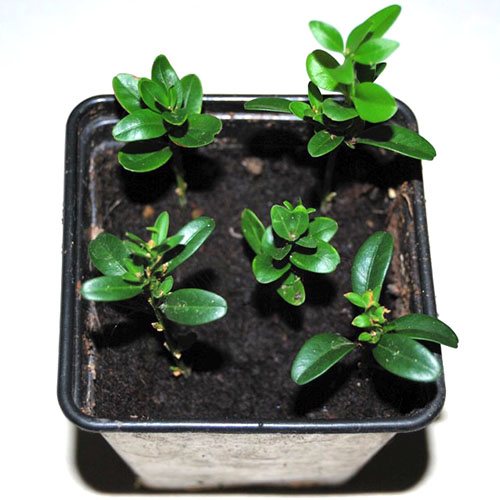

In natural habitats, boxwood reproduces both vegetatively and by seeds that are formed in capsule fruits and literally shoot out as many meters after ripening.
To speed up the process and facilitate care, at home reproduction of boxwood is carried out using cuttings. You can get cuttings twice a year.
- In the summer months, young shoots that have recently lignified at the base are cut off for planting. In most cases, you can get these cuttings in June and July.
- In the last days of summer or at the beginning of September, you can also cut cuttings up to 10 cm long, containing 2-3 internodes.
The planting material is planted under a film in a moistened mixture of peat and garden soil.
At home, boxwood can also be propagated by layering obtained from young shoots inclined to the soil.
On such a branch, a cut of the bark with a fragment of wood is made and the shoot is pressed to the ground, securing this position with a wire bracket and directing the upper part of the layering vertically. Rooting boxwood can take up to three weeks. You can speed up the process with the help of growth stimulants, regular watering and a little heating of the soil. When young plants give roots, they are planted at a distance of 10 cm from each other or in separate small pots.
